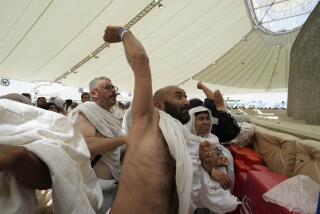New Moon : Muslims Turning to Astronomy to Calculate End of Ramadan
- Share via
Following the advice of astronomers rather than relying on the traditional sighting of the new moon, most large Southland mosques ended the Islamic fasting month of Ramadan in mass prayer gatherings Friday, breaking with Muslim custom by observing a date determined weeks before.
Although the issue of science versus religion is not new to Islam, this was the first time that leaders of the largest mosques in Los Angeles and Orange counties established the start and end of Ramadan based on the predicted position of the moon.
The sayings of the Prophet Mohammed, who founded Islam in 622, direct that the Ramadan month of daytime fasting should end after the slim crescent of the new moon is seen.
However, a committee of eight American Muslim scientists and engineers met in early January and established that the earliest possible sighting of the new moon would be Thursday night, making Friday the first day of the three-day Eid al-Fitr celebration that marks the end of Ramadan.
Islamic leaders at 15 Southern California centers said in a statement issued Jan. 26 that they will work toward “formulation of an Islamic calendar for years to come,” establishing dates by calculating the highly predictable movements of the moon instead of relying on actually seeing it.
Some Muslims are unhappy with the change, noting that some followers of Islam in the Middle East reported seeing the lunar crescent Wednesday night and began the three-day Eid al-Fitr with Thursday morning prayers.
Indeed, Islamic groups in West Los Angeles, Culver City, Riverside and Anaheim, relying on those overseas reports, also began celebrating the holiday Thursday.
Majdi Ataya, a spokesman for the Islamic Center of Anaheim and critic of the calendar setting group, said, “What they are doing is unacceptable. They are contradicting the rules of the religion.”
Although the Islamic Center of Southern California has followed astronomical calculations since 1984, the change this year was a departure for centers such as those in Garden Grove, Northridge and the San Gabriel Valley, which have relied on actual sightings.
Organized Islam in America is leaning toward using the scientific calculations, said Nihad Owad, executive director of the Council on American-Islamic Relations in Washington.
Having the date for Eid al-Fitr known weeks in advance allowed Muslim workers and schoolchildren to plan to take the day off.
“I can understand that in Southern California, with people coming from so many different countries, there is a desire to make things less confusing and be more unified,” said UCLA historian Michael Morony, a specialist in Islamic history who is not a Muslim. The debate over whether to rely on science or religious tradition derives largely from two forces, Morony said.
“The Islamic world has had a highly developed astronomical and mathematical tradition since at least the 8th Century,” Morony said. But “Muslims have a historical opposition to astrology--the idea that the movement of the planets and moon is linked to one’s fate--and, at least in the popular mind, astrology has been associated with astronomy.”
The other element, he said, is simply “who gets to say what--the scientists or the religious authorities.”






